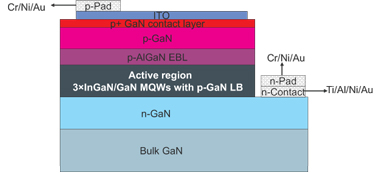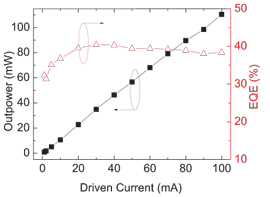
| Home | About Us | Contribute | Bookstore | Advertising | Subscribe for Free NOW! |
| News Archive | Features | Events | Recruitment | Directory |
News
7 July 2010
Semipolar blue LED with 39.5% external quantum efficiency
University of California Santa Barbara (UCSB) researchers have used semipolar (10-1-1) nitride semiconductor material to create blue (~450nm wavelength) light-emitting diodes (LEDs) with external quantum efficiencies (EQEs) of 39.5% at a drive current of 20mA [Yuji Zhao et al, Jpn. J. Appl. Phys., vol49 p070206, 2010]. This beats a previous highest EQE of 29% for a comparable blue semipolar (10-1-1) device.
The use of devices grown in nonpolar and semipolar directions reduces or eliminates internal electric polarization fields, and it has been hoped that improved light emission could result when compared with c-plane (0001) devices. These hopes have not been realized due to the difficulty of growing high-quality nitride semiconductor material in these directions. The leading c-plane devices have maximum EQEs of the order of 60%. Nonpolar and semipolar devices have suffered from high densities of threading dislocations and basal plane stacking faults that tend to kill performance.
Improvements in material quality have recently been enabled for these materials by the use of new low-defect-density free-standing gallium nitride (GaN) bulk substrates. UCSB used free-standing (10-1-1) GaN substrates from Japan’s Mitsubishi Chemical Corp.
The UCSB result was based on an optimization of the metal-organic chemical vapor deposition (MOCVD) and of the device structure (Figure 1) in terms of the well width and barrier thicknesses, including the last barrier (LB) of the three-period multi-quantum-well (MQW) active region. The optimum indium gallium nitride (InGaN) well width (undoped) was found to be about 3nm. The optimum for undoped GaN barriers was 17.5nm. The effect of LB thickness was less important as long as it was between 8nm and 16nm. Increasing the LB to 20nm impacted performance, possibly due to the thicker LBs hindering hole injection into the active region.

Figure 1: Schematic view of UCSB’s semipolar (10-1-1) LED device structure.
Also, the magnesium (Mg) doping used to create the p-contact layer and the last barrier was optimized. The last barrier before the p-contact layers was doped, presumably to ensure that more holes entered the MQW than is usual with undoped last barriers. In some LED structures, it has been found that the holes can be confined to the p-end of the active region, reducing the expected light output from electron–hole recombination. However, it was found that performance was relatively insensitive to LB doping. The doping of the p+-contact layer was more important, with a step-increase in device performance with a flow of about 0.05μmole/min for the bis(cyclopentadienyl)magnesium (Cp2Mg) Mg source. The researchers report that a systematic study for doping on device performance is under investigation.
The n-GaN contact layer was 1μm thick. Silicon was used for n-type doping. A 16nm aluminum gallium nitride (AlGaN) electron-blocking layer (EBL) was also used to reduce electron overshoot into the p-contact where non-radiative and/or parasitic non-blue emitting recombination occurs.
The optimized UCSB devices did not include any special light extraction techniques, although a new LED structure with improved light extraction efficiency is under investigation with a view to future publication.
 Figure 2: Light output power vs current (L–I) and external quantum efficiency vs current (EQE–I) curves for typical UCSB optimized (10-1-1) LED under pulsed conditions.
Figure 2: Light output power vs current (L–I) and external quantum efficiency vs current (EQE–I) curves for typical UCSB optimized (10-1-1) LED under pulsed conditions.
The final devices were tested under pulsed operation (1% duty cycle), and the light output power (L) and EQE were determined (Figure 2). The value of L was 22.75mW at 20mA and 110.50mW at 100mA. The EQE at 100mA (38.4%) was slightly down on the 20mA value. This is a rather small ‘efficiency droop’ compared with previous studies.
![]() Search: Semipolar blue LED MQW InGaN Free-standing GaN bulk substrates
Search: Semipolar blue LED MQW InGaN Free-standing GaN bulk substrates
Visit: http://jjap.ipap.jp
The author Mike Cooke is a freelance technology journalist who has worked in the semiconductor and advanced technology sectors since 1997.